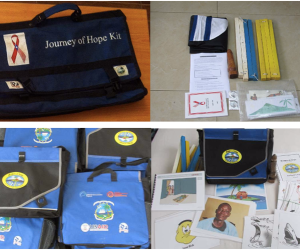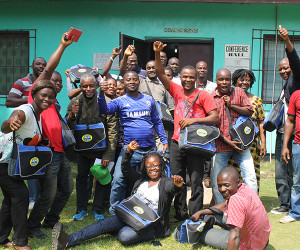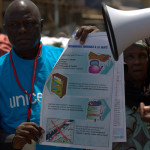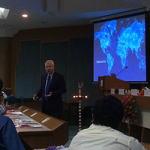Bridges of Hope: A Community Toolkit for Ebola Education and Healthy Behaviors
Stephen K Gbollie’s story could be anybody’s in Liberia: He believes he contracted Ebola by holding a contaminated phone that belonged to a friend with the disease. Following public health guidelines, Stephen isolated himself and was transported to an Ebola Treatment Unit (ETU) in Monrovia. He recovered, but his ordeal didn’t end there. As a survivor, Stephen faced stigma and rejection until he returned to his home in Kakata.
Now, his experience stands as a lesson for others on how to prevent the pain he endured as an Ebola victim and survivor.
Stephen’s account is one of five stories of Ebola survivors included in Bridges of Hope (BOH), a community toolkit the Health Communication Capacity Collaborative (HC3) adapted to engage communities in Ebola education and to discuss other health risks.
In BOH discussions, general Community Health Volunteers (gCHVs) encourage participants to put themselves in the shoes of the Ebola survivors to gain insight into their fear, stigma and sense of isolation. Their stories also help audiences understand how Ebola is transmitted and how it can be prevented. Survivors who are immune to Ebola also demonstrate the valuable role they can play caring for the sick in their communities.
“I feel good because my story gives an example,” Stephen says. “It can help somebody who may have Ebola to get tested, receive care and protect my family that I did.”
The Ebola adaptation of the BOH toolkit came together quickly. Under enormous pressure to respond quickly to the Ebola outbreak, HC3 and its partners faced a treacherous moving target. SMS polls, surveys, community discussions and other techniques provided a real-time picture of communication needs as the disease spread. But even as they responded to the crisis as it unfolded, the staff had to anticipate and prepare for future communication interventions to help the health system rebuild and to prevent another outbreak. Through rapid pre-testing, focus groups, consultations with health workers, illustrators, Ebola survivors and others, the team retooled BOH — originally created for community-level or workplace HIV prevention activities in South Africa.

Bridges of Hope kits were quickly adapted from Journeys of Hope kits for HC3’s Ebola response in Liberia.
The sense of urgency surrounding Ebola “forced us to think about our work in a whole new way,” says Elizabeth Serlemitsos, HC3’s Ebola program director in Liberia. “We had to deliver something really fast yet we still had to consult all the relevant partners,” she says. The same pieces had to fall into place, but in a highly compressed timeline; HC3 accomplished in six weeks what “normally takes six months or even longer.”
As HC3 raced to get in front of the Ebola outbreak, it was important not to cut corners. Pretesting the BOH training package, for instance, can’t be skipped, according to Serlemitsos. During the pre-testing process, pre-test participants looked at an image intended by BOH designers to be a treasure chest, a symbol of goals and dreams. Instead, these reviewers interpreted the image as a coffin, which is obviously something very different — especially in the context of Ebola. “We didn’t see that until somebody pointed it out,” Serlemitsos says. “That will forever be in my set of examples of why pre-testing is absolutely necessary.”
As Ebola began to ebb in early January, HC3 revised the toolkit to address health threats such as malaria, unintended pregnancy, safe motherhood and other concerns overlooked in the heat of the epidemic. Once the materials were approved, assembled and printed, master trainers carried the toolkits into the field where they initiated training. Ultimately, more than 1,200 gCHVs and facility level staff will lead BOH activities in nine out of 15 counties.
BOH participants learn how Stephen, a father of four, protected his family and community by isolating himself, getting tested at an ETU and abstaining from sex for at least three months after recovery. His experience “highlighted key issues and his story was compelling,” says Katie Frank, Senior Communication Advisor for HC3’s Ebola Program.
A vaccinator at a clinic in Liberia’s Margibi County, Stephen also oversees cGHVs from his district as they conduct BOH activities. “Now that Ebola is gone, everybody is free to go about their normal activities, but not forgetting those preventive measures to avoid the reoccurrence of this virus.”









Leave a Reply
Want to join the discussion?Feel free to contribute!